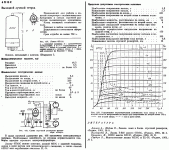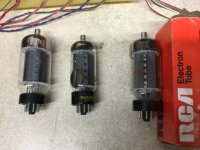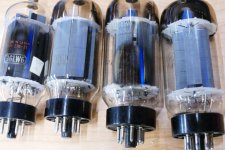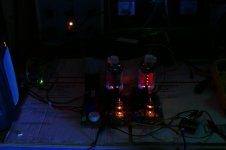Since the grid 2 voltage is fixed, one could drop that down to 150V for use with a Sweep tube. A Novar tube like 6JG6A could work then if it were not for taking twice the heater power (1.6A at 6.3V). (2.5" to 2.75" seated height, 1.5" diam.)
Twice the heater power is why you can get high plate current at low G2 voltage. IIRC, the Fisher 400 power transformer runs hotter than the blazes of Hell and Damnation as it is. Used to have one, until some Philips ECG 7868’s ran away, red plated and burnt up the power and output transformers. Ran hot even with the original tubes - two of them cracked and Eventually got gassy (necessitating replacement). Should have kept the two good ones - would have saved at least one output transformer.
Yeah, there is no cathode safety resistor under the 7868 tubes on the Fisher 400 schematic. And true enough, a big wide cathode, to get the higher gm (and high current capability), takes more heater power. The 7868 must have a very fine pitch or close (to cathode) grid 1 to get the 10000 gm at just 0.8 A heater) The 6JG6A has 3X the cathode current capability of the 7868.
The seal tip on top of the 6GT5 is taking up a 1/4 inch. 6JG6A has the seal tip on the bottom.
A little better fit might be 6HB5A (21HB5A actually). It has 10,000 gm at 60 mA, just like the 7868, and 18 Watt diss. (more like 24 Watt for audio purposes) and uses a 1.5 A heater power at 6.3V. It's spec'd at 3" max height, but the ones I have measure at 2.75". Still would need a 150V screen supply. The Novar 17KV6A is similar to the 21HB5A, but has the seal tip on top (at least some of them, mainly Sylvania ones I think), making those too tall. (GE ones might fit though )
I'm doubtful that any of these 1.5" diameter tubes would actually fit into the tight space allotted in the Fisher 400 for the outputs. It even has a reflector behind the 1" diam. 7868 tubes, since they nearly touch the chassis there.
Practically speaking, one is left with the newer 7868 tubes, or 7591A tubes. Fix up the grid 1 resistor and put in a small cathode resistor, plus grid 2 safety resistors. Or sell the thing.
The seal tip on top of the 6GT5 is taking up a 1/4 inch. 6JG6A has the seal tip on the bottom.
A little better fit might be 6HB5A (21HB5A actually). It has 10,000 gm at 60 mA, just like the 7868, and 18 Watt diss. (more like 24 Watt for audio purposes) and uses a 1.5 A heater power at 6.3V. It's spec'd at 3" max height, but the ones I have measure at 2.75". Still would need a 150V screen supply. The Novar 17KV6A is similar to the 21HB5A, but has the seal tip on top (at least some of them, mainly Sylvania ones I think), making those too tall. (GE ones might fit though )
I'm doubtful that any of these 1.5" diameter tubes would actually fit into the tight space allotted in the Fisher 400 for the outputs. It even has a reflector behind the 1" diam. 7868 tubes, since they nearly touch the chassis there.
Practically speaking, one is left with the newer 7868 tubes, or 7591A tubes. Fix up the grid 1 resistor and put in a small cathode resistor, plus grid 2 safety resistors. Or sell the thing.
Last edited:
I'm doubtful that any of these 1.5" diameter tubes would actually fit into the tight space allotted in the Fisher 400 for the outputs. It even has a reflector behind the 1" diam. 7868 tubes, since they nearly touch the chassis there.
Yeah it's pretty tight with the stock tubes, so there's no way a bunch of fat Compactrons are going to fit. Too bad, cause there's lots of 18 watt tubes to choose from. You would have to make an "L" shaped plate to mount the sockets on and the tubes would be sticking out the back horizontally.😱
jeff
Last edited:
A Shoe-horn fit tube:
The 25HX5 is 1 1/8" diameter like the 7868, but 2 - 7/8 inch tall, exclusive of the seal tip, which takes it up to 3 - 3/16" height. This tube is a 14 Watt version of the EL36 Vertical Sweep, but without a plate cap. Magnoval base. 400V / 300V ratings. Wants like 100V on grid 2. 10,800 gm at 60 mA, similar to the 7868. One would need to lower the socket some with washers on the mounting bolts to get it to fit, or drill a small hole in the cover for the tip.
Maybe there are some other European tubes (similar form factor) but without the seal tip. I'm not familiar with them all.
The 25HX5 is 1 1/8" diameter like the 7868, but 2 - 7/8 inch tall, exclusive of the seal tip, which takes it up to 3 - 3/16" height. This tube is a 14 Watt version of the EL36 Vertical Sweep, but without a plate cap. Magnoval base. 400V / 300V ratings. Wants like 100V on grid 2. 10,800 gm at 60 mA, similar to the 7868. One would need to lower the socket some with washers on the mounting bolts to get it to fit, or drill a small hole in the cover for the tip.
Maybe there are some other European tubes (similar form factor) but without the seal tip. I'm not familiar with them all.
Last edited:
The Russian 6P13S works well with a voltage of ~420V on G2 with a slightly higher negative voltage on G1 without any traces of overheating and instability. Physically, it looks very similar to 6P31S (EL36), but it differs from it in terms of characteristics.
"Complete" list of sweep tubes
"Complete" list of sweep tubes
Attachments
So how much different are the new EH’s from the original 7868/7591? Would it be bad enough to require a redesign, or would adjusting bias be enough in a circuit which calls for them?
Back to sweep tubes, I have one that’s a mystery to me anyway. Most of my 26/36LW6’s are the large bottle variety (left) . A handful in the small bottle (center). Both look similar inside. GE and RCA exactly the same, and Sylvania a bit different but obviously intended to be the same. But I also have exactly ONE 26LW6 on the right. It looks like it has two complete separate plates (tied together at the pins). And altogether much more internal mass than the others. Were these common at all - IOW, will I likely ever find a mate?
Attachments
Wow, I like it very much!Here is the 13GF7 large triode section ( equiv. to 6EM7) in native mode and using the new series Schade Fdbk ( = George's CED, UnSet).
The series Schade version is set up for 1/2 the Mu of the native triode in order to get some loop gain for correction. Input V steps are 6V for both, with 50 mA/div Vert. and 50V/div Horiz. scale. With the limited loop gain (5.4 /2) you get limited correction, but still looking fairly good. A lot less roll-over in the curves, but still some present. A super cheap way to turn the $1 13GF7 into a 2A3.
For really super correction, a beam Sweep tube ( $1 21HB5A here) has high gain available for correction, so almost vanishing roll-over in the corrected "triode" curves, and low Rp with high gm besides. A super cheap 211 that runs on reasonable B+ voltage. (one can get less correction by setting a higher net gain, so 2A3 like curves can still be done with a Sweep tube if desired )
a) native 13GF7 (big triode section)
b) series Schaded 13GF7 ( " " )
c) series Schaded 21HB5A sweep tube
d) native internal triode 21HB5A
It give me ideas... I need a 6W-10W (6 to 10W have almost no difference in dB terms) amplifier for next project, and I have a lot of 6EM7, so this will be an opportunity (far better than the limited and full of rollover inverted mode)
In PP mode I already made 6W amps with 6EM7
The pre section have a good linearity when CCS loaded, and plenty of µ
Another alternative I have for "UnSETting" is the ECL82, who knows... decisions, decisions
I have one that’s a mystery to me anyway.....I also have exactly ONE 26LW6 on the right.
The 6LW6/26LW6/36LW6 tubes are all made by one of three vendors regardless of whose name is on the tube. All of them went through several iterations to improve quality, or reduce cost during their production run.
The tube on the left is made in Japan. Some say Hitachi, some say Toshiba. I don't know for sure, I have two, both well used, and they are not exactly identical inside, but both wear the elongated octagon around the type number. It has the beefiest guts and weighs the most. I have not tested them for power handling capability.
Next to it is a Sylvania made tube that wears no brand name. Sylvania tubes usually have the type number in thin letters with the letters USA underneath the numbers. Note no periods between the "USA" letters. This one has rather wide fins attached to the plates to help radiate heat. I have only seen large fins on Sylvania 6LW6's. The Sylvania 26 and 36LW6's have small fins and usually come in the skinny bottle like yours.
The fat 6LW6 further to the right is like your twin plate version. It is made by GE. GE tubes have the type number etched into the glass in a thicker font than Sylvania uses. The U.S.A. label is etched into the glass below the type number with the periods between the letters. GE tubes usually have the "dot code" below the U.S.A. Some say this is a date code, others say it is a lot or batch code.
The twin plate 6WL6 is rather rare, and eats by far the most power of any of the xLW6's. Red plate doesn't occur until 80 to 90 watts of continuous dissipation. I have two or three of these and all are 6LW6's. I have never seen a 26LW6 version, but I have only a few 26LW6's. Most of my tubes are 36LW6's since I was able to get these for under $10 each until recently.
The fat tube on the right is a GE 26LW6 with the small plate fins. These are quite common. I have seen the same guts in the small bottle GE xLW6 tubes.
Most of the xLW6's with large fins attached to the plate were rather early vintage. I have seen several different fin structures attached to the plates in fat bottled GE tubes. GE apparently revised the fin structure several times in the first few years. I'm guessing that there were alignment issues with putting all of this together, since a portion of the fin extends inside the plate. Some of these tubes seem to suffer from hot spotting with localized red spots appearing around 40 to 50 watts, while other finned tubes will eat 70 to 90 watts.
Latter tubes got smaller fins attached to the typical two piece plate, and eventually all the bottles went on a diet. The fat small fin GE's seem to turn red in the 60 to 70 watt range with a little less for the similar Sylvanias. The skinny tubes also tend to give up a watt or three in the max power test, but any well made xLW6 can eat 50 to 60 watts for hours.
Some tubes do have alignment issues, and may red plate on one side, and not the other. These should not be pushed beyond 40 watts, or less if red plate shows.
The second picture shows a pair of "Lindal" branded 36LW6's cranking out 250 watts of continuous sine wave at 3% THD in a push pull amp. The Lindal 36LW6 is a relabeled "rejected" GE small fin fat bottle tube. These both red plate evenly, but one is hotter due to unequal GM and drive levels. The idle currents are matched. The hot tube is dissipating about 75 watts, and had been running at that level for about 5 minutes when I took the picture.
Attachments
Last edited:
My wish is for Tubelab_com https://www.diyaudio.com/forums/members/tubelab_com.html
to do a vlog of his ventures in audio on youtube.
How great would that be.Oh and educational too!
I'm a fan.
Thanks for all your work!
to do a vlog of his ventures in audio on youtube.
How great would that be.Oh and educational too!
I'm a fan.
Thanks for all your work!
This is it for now:
75 watt per channel triode mode tube amp prototype - YouTube
it was a spur of the moment thing shot with a hand held cheap phone for a video camera. In two and a half years it has received about 1000 views.
I have been asked a few times for a video build up of one of the popular Tubelab boards, but I don't know if there is really any interest there.
It seems that most viewers just want some "blow stuff up" videos......I could do that too........
75 watt per channel triode mode tube amp prototype - YouTube
it was a spur of the moment thing shot with a hand held cheap phone for a video camera. In two and a half years it has received about 1000 views.
I have been asked a few times for a video build up of one of the popular Tubelab boards, but I don't know if there is really any interest there.
It seems that most viewers just want some "blow stuff up" videos......I could do that too........
i too am dreaming of the day i can come up with a 300 watter from a pair of QE08-200, member Tobias has started.....i am waiting for funds to come.....
750vdc B+ not as scary as over 1kv's but just as hazardous...
750vdc B+ not as scary as over 1kv's but just as hazardous...
Is it possible use a twin triode tube like 6AS7 or any other in parallel with a 5k primary OTP, 8 ohm secondary? .....all the best
Thanks PCL200 however I did not ask specifically for the 6AS7 was just an example...all the best
SE or PP? Either way 5k is high for a power triode like that or even for triode strapped sweep tubes since we can get lots of current for low voltages (even if the mu IS crap).
I built a PPP (two bottles per channel) 6as7 amp with a 600R load. It was a little too low but you get the idea. 1k3 would have been good I think.
I built a PPP (two bottles per channel) 6as7 amp with a 600R load. It was a little too low but you get the idea. 1k3 would have been good I think.
Is it possible use a twin triode tube like 6AS7 or any other in parallel with a 5k primary OTP, 8 ohm secondary?
You, asked a very general question which can not be answered without knowing if your 5K OPT is SE or P-P.
In the SE case, possible, yes. Optimum, no.
As stated 5K is a rather high load impedance. A 5K SE OPT likes a B+ voltage in the 300 to 500 volt range depending on the desired power output. This is too much for a 6AS7. A triode wired 6V6 will make 2 watts into 5K on 320 volts, most other similarly sized tubes should do 1.5 to 2.5 watts on 325 volts or so into 5K. The 6AS7 on 250 volts might get you a watt. I don't know for sure, since I have never tried it.
A bigger tube like a 6L6GC, EL34 or KT88 can make 6 to 8 watts into a 5K OPT, but you need 400 to 450 volts of B+ to get there.
IN the Push Pull case each tube will see about 1250 ohms. Here you can get 10 to 15 watts on 350 volts, and lots more with 450 volts. I believe I was getting about 15 watts with 6AS7's into 5K but I don't remember the exact B+ voltage, it was 15 years ago.
- Home
- Amplifiers
- Tubes / Valves
- Those Magnificent Television Tubes



